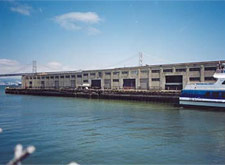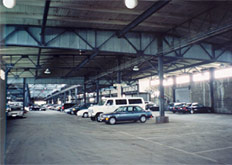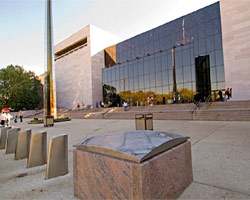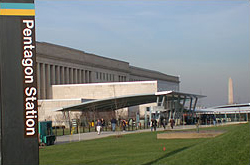Accommodate Life Safety and Security Needs
Last updated: 10-05-2008
Overview

This federal courthouse in Tucson, AZ offers an imaginative solution for vehicle barriers: a row of lush palm trees. These trees provide a structural barrier and welcome relief from the desert sun in an otherwise spartan plaza.
Most building projects place a higher priority on the protection of building occupants and assets than on the preservation of cultural resources. However, it is important to address the protection of the building's historic spaces, finishes, and collections in the design and implementation of safety and security measures. Because historic buildings are each a unique case, cost effective, synergistic, performance solutions developed in a collaborative environment will produce the best results. See also WBDG Whole Building Approach.
Designers, facility managers, fire, security and code officials, curators, preservation officials, and building occupants should be involved early on in the planning and design process. This allows the project team to look at issues holistically and remain flexible to the challenges of the historic property.
Recommendations
Incorporate Life Safety Codes


Mezzanine in former auto showroom, extended invisibly with the use of glass. Richmond, Virginia.
Photos courtesy of the National Park Service
The primary codes that address life safety are NFPA 101, Life Safety Code; the International Building Code; and NFPA 914, Code for Fire Protection of Historic Structures. NFPA 914 addresses performance approaches and equivalencies for achieving code compliance. Application of these codes should be done in consultation with code authorities and preservation experts. A number of states have enacted rehabilitation and historic building codes that may lessen the alteration of historic material. These codes address the following issues, depending on type of use:

Glass partition in a former school stair hall. Doors will automatically close in the event of a fire. Richmond, Virginia.
Photo courtesy of the National Park Service

Glass partition in a former school stair hall. Doors will automatically close in the event of a fire. Richmond, Virginia.
Photo courtesy of the National Park Service
- Egress: Preserve the primary, main, ceremonial entrance experience. Where existing stairs cannot be brought into compliance without significantly changing the character of the spaces, additional means of egress should be carefully located to preserve significant spaces while providing a minimum of two means of egress.
- Fire and Smoke Separation: Design smoke separation to avoid subdividing or obscuring significant spaces, such as stairways, corridors, entry areas.
- Fire and Smoke Detection: Early detection of heat and smoke is critical to extinguishing fires with minimum damage to historic resources. Very early response/detection systems can eliminate the need for suppression systems. See also Technical Preservation Guideline 3.1—Fire Safety Retrofitting, U.S. General Services Administration, Public Buildings Service, 2001. This publication provides guidance on location of detection devices unobtrusively.
- Fire Suppression Systems: The purpose of fire suppression systems is to cover all surfaces evenly. However, this can result in damage to historic finishes. Evaluate fire loads to determine appropriate protection. Use computer modeling to identify high-risk areas. Select and locate fire suppression systems to minimize water and subsequent mold damage to historic fabric. Alternative suppression systems such as dry systems (where lines are not filled with water), mist systems, and time delay with alarms prior to activation, help reduce water damage. Halon systems may be useful in small, contained areas where high-value, water sensitive collections are present. Careful and sensitive installation of suppression systems is critical to the preservation of the character of historic spaces. See the WBDG Secure/Safe—Plan for Fire Protection.
- Operational Considerations: Include operational and management solutions for life safety and historic preservation when designing the systems. Ensure that staff and occupants are trained to respond promptly and summon additional resources in event of an emergency situation.


Retention of glass doors along historic corridor by incorporating new, code compliant doors on the interior. Ottawa, Kansas.
Photos courtesy of the National Park Service
Integrate Seismic Upgrades
Increased concern about seismic risk has led to more stringent requirements that can negatively impact historic buildings. Un-reinforced masonry construction, common to many historic buildings and structures, is particularly susceptible to damage in seismic events. The challenge of seismic upgrades in historic buildings is to accommodate strengthening in ways that do not interfere with the building façade or the volume and features of significant public spaces. For these reasons the input of qualified structural engineers with knowledge of and experience in preservation of historic buildings is essential. (Refer also to WBDG Seismic Design Principles). Wherever possible:




Seismic upgrades in rehabilitated pier building are not readily apparent, but are code compliant. San Francisco, California.
Photos courtesy of the National Park Service
Coordinate proposed seismic upgrades with other structural improvements such as strengthening of buildings to prevent progressive collapse as part of anti-terrorism force protection measures. (Refer also to WBDG Historic—Update Systems Appropriately, Structural section); and Preservation Brief 41: The Seismic Retrofit of Historic Buildings: Keeping Preservation in the Forefront by David W. Look, AIA, Terry Wong, PE, and Sylvia Rose Augustus. National Park Service.
Provide Building Security

A new concept design for security at the Federal Triangle in Washington, DC beautifies the sidewalk by incorporating barriers into garden walls. This inviting landscape includes new amenities such as benches and sculptural features.
General building security involves technical, physical, and operational solutions with appropriate redundancies. Before security measures are designed, a threat/vulnerability assessment and risk analysis should be conducted to determine the potential threats and acceptable levels of risk. In regards to historic preservation, wherever possible:
- Integrate security design to minimize visual and other impacts on the historic fabric of the building. A principle goal of the entry experience is to maintain a setting that is welcoming to the visitor.
- Seek opportunities to create amenities that are seamless with historic character.
- Seek opportunities to create public spaces that address security measures and enhance historic character (e.g., standoff distances reduce the need to modify buildings).
Consider the following issues when designing security against terrorism for a historic property refer also to WBDG Retrofitting Existing Buildings to Resist Explosive Threats and ATFP.


Left: U.S. Capitol Building security upgrades: bollards activated when required;
Right: National Gallery of Art - security upgrades at the East Wing, Washington, DC.
Photo courtesy of the Smithsonian Institution
- Site Planning: The goal for site planning is to maximize standoff distance for potential large explosive devices and to provide clear zones adjacent to the building to facilitate observation of small explosive devices. Care must be taken to avoid significant alteration to historic landscaping. Impact-engineered site furniture and appropriately designed bollards can enhance both site amenity and security.
- Architecture
- Replacement of historic windows can frequently be avoided with the addition of blast-resistant interior storm windows and/or blast curtains to prevent glass fragmentation hazards (refer also to WBDG Glazing Hazard Mitigation and Retrofitting Existing Buildings to Resist Explosive Threats).
- Doors are generally required to open outward, and blast resistant doors may be required in some situations. Replacement of historic doors can often be avoided by closing an entrance or providing an additional set of doors to provide the required protection.
- Materials and products exist that resemble historic materials but may offer more security.
- Internal layout of spaces is important to provide entry control and protection of critical resources. If new features are required, they should comply with code and be compatible with the original design.
- Some historic architectural elements, including ceiling elements and tiles, light fixtures and equipment, should be secured or reinforced to prevent injury and loss in security or seismic events.
- Structural: Prevention of progressive collapse is required for buildings of three stories or more. Building modifications need to consider the threat level, structural analysis, and review of design alternatives as they relate to preservation issues. Furring in of exterior walls should be avoided where it impacts historic finishes or changes the volume and proportions of significant spaces. For guidance on sensitive building systems upgrades, refer to Historic—Update Building Systems Appropriately.
- Electrical: Electrical issues relate to provision of power and emergency lighting as well as means of mass notification. Installing emergency generators for existing historic fixtures can eliminate the need for intrusive secondary lighting systems. Notification devices and detection equipment should be integrated to avoid damage or disruption of historic finishes. For guidance on sensitive building systems upgrades, refer to Historic—Update Building Systems Appropriately.
- Heating, Ventilation, and Air-Conditioning (HVAC): HVAC systems must be installed and protected to prevent the entry of external contaminants. They also should allow for the isolation of contaminants and the exhaust of smoke in support of building evacuation. In general, make every effort to minimize impact on the historic fabric of the building. For guidance on sensitive building systems upgrades, refer to Historic—Update Building Systems Appropriately.
Example: Pentagon Remote Delivery Facility and Metro Entrance Facility Renovation Program

Pentagon Reservation with Metro entrance facility (left) and remote delivery facility with landscaped parade ground (right foreground) Arlington, VA.
Photo Courtesty of DoD
Pentagon Remote Delivery Facility (RDF)

Remote delivery facility with landscaped parade ground
The RDF is a 250,000 square foot shipping and receiving facility adjoining the Pentagon. The RDF significantly improved the physical security of the Pentagon by providing a secure consolidated location to receive and screen thousands of items shipped to the building each day. A landscaped roof provides new green space with indigenous vegetation and water reuse in what was once an asphalt parking lot. The roof landscaping also reduces storm water volume on the site and heat loading of the facility. The RDF is registered as a pilot project with the U.S. Green Building Council's Leadership in Energy and Environmental Design (LEED) program. The facility includes a building control system for energy efficiency and indoor air quality.
The Pentagon was declared a National Historic Landmark in 1992. This landmark protects five contributing architectural features of the Pentagon, including the Mall Terrace façade. By conforming the one-story receiving facility to the shape of the existing site, bordered by two highways, it actually improved site lines to the Pentagon's historic Mall Terrace. The façade of the RDF replicates the look and feel of the original Indiana limestone used on the exterior of the Pentagon in the 1940s.
Pentagon Metro Entrance Facility (MEF)
The MEF was a congressionally mandated security project to relocate the Pentagon bus station further from the building and to create a secure screening facility for visitors entering the Pentagon. Balancing the security needs of the Department of Defense while creating a welcoming and historically sensitive "front door" to the Pentagon is a difficult balancing act made possible with sustainable solutions. The design of the MEF uses landscaped dirt berms to mitigate the potential effects of a blast. Self-cleaning Teflon-coated fiberglass canopies protect pedestrians from the foul weather and will not fragment in the event of an explosion (as is the case with glass or other less flexible materials).
Pentagon Renovation (PENREN) Goals for Sustainable Construction
- Use resources efficiently
- Minimize raw material resource consumption, including energy, water, land and materials, both during the construction as well as throughout the life of the facility.
- Reuse resources
- Use renewable energy sources
- Create a healthy working environment
- Build facilities of long-term value
- Protect and/or restore natural environment
The MEF is the first Department of Defense facility to receive Leadership in Energy and Environmental Design (LEED™) certification from the U.S. Green Building Council. The following features design and construction features contribute to the LEED Certification:
- At least 50% of waste was diverted from landfill
- Electric vehicle outlets installed
- Vegetation covers half the open space restoring life back to the site
- High reflectance Energy Star roofing installed
- 20% savings in energy consumption
- Over 50% of the building materials were assembled within 500 miles
- Over 50% of the materials contain recycled content
- 21% of wood-based materials were FSC certified
- Permanent CO2 monitoring systems installed
- Registered as a LEED project
The National Capital Planning Commission and Commission of Fine Arts cited the MEF as an exemplary project. Like the RDF, the façade of the MEF matches the existing exterior of the Pentagon to complement the appearance of the historic building. The MEF was subject to review by the Virginia State Historic Preservation Officer and other governmental review commissions since the Pentagon is a listed National Historic Landmark. PENREN adhered to the Secretary of Interior's Standards throughout the design and construction of the project.

Metro entrance facility (fiberglass canopy) with Pentagon security entrance and visitor screening center (terrazzo structure adjacent to Pentagon building)
PENREN chose finish materials for the security entrance and visitor center that enhance sustainability of the facility (e.g. terrazzo, certified wood, recycled content ceiling panels). Designers incorporated skylights to bring natural light into the facility thereby reducing the use of artificial lighting. The skylights allow visitors and personnel to see the monumental façade of the Pentagon (restored during the project) when ascending the escalators from the security area into the Pentagon proper.
LEED points earned on the RDF and MEF projects combine to certify the entire Pentagon Reservation under the U.S. Green Building Council's pilot program, LEED for Existing Buildings.
Emerging Issues
Smart Codes
Although fire safety improvements—particularly early warning detection and quick response suppression—help to reduce the risk of devastating historic building losses, their potential to compromise historic fabric often leads to resistance against egress code compliance. Fortunately, two important trends are converging to support flexible approaches to egress code compliance: 1) alternative codes for historic and non-historic existing buildings and 2) technological advances that compensate for fire safety deficiencies and offer less intrusive solutions for prescriptive code compliance.
The general intent of life safety codes is to ensure prompt escape of building occupants, in the event of a fire, to a safe area. The code addresses construction features such as the a) width, length, and fire resistance of exit paths and b) ability of construction materials to contain fire and prevent its spread; fire protection features such as smoke detection devices, alarms, and fire suppression systems; occupancy and operational features such as emergency evacuation planning; and fire precautions during construction.
Increasing recognition that compliance with prescriptive codes written principally to guide new construction, onerous enough to discourage investment in older urban areas, has led states such as New Jersey (New Jersey Rehabilitation Sub-Code [1999]) and Maryland (Maryland Building Rehabilitation Code) to adopt Smart Codes, or Rehabilitation codes that provide flexibility to achieve life safety goals without wholesale building reconfiguration.
In 2000 the U.S. Department of Housing and Urban Development released an updated and expanded edition of Fire Ratings of Archaic Materials and Assemblies with the expressed goal of promoting the preservation and reuse of America's older housing and building stock. This guide provides fire ratings for a wide variety of materials and assemblies found in buildings from the nineteenth to the mid-twentieth centuries, as well as methods for calculating the fire resistance of general classes of archaic materials and assemblies for which no documentation is available. The 2000 edition also includes an array of details developed by English Heritage for upgrading the fire resistance of wood panel doors. The document has found widespread acceptance among code officials and has been incorporated into numerous state and local building codes, model code publications, and (U.S.) National Fire Protection Association standards.
In addition, the National Fire Protection Association (NFPA) 914 Code for Fire Protection in Historic Structures provides alternatives, including performance-based approaches and operational solutions, for meeting the intent of the NFPA Life Safety Code within the framework of the Secretary of the Interior's Standards for the Treatment of Historic Properties. The intent of NFPA 914 is to ensure prompt escape of building occupants while minimizing the impact of fire and fire protection on the structure, contents, and architectural features that give a building its historic character.
Relevant Codes and Standards
Life Safety
- 1997 Uniform Code for Building Conservation
- 2003 International Building Code
- Guideline on Fire Ratings of Archaic Materials and Assemblies, U.S. Department of Housing and Urban Development, 2000.
- International Existing Building Code, International Code Council, 2003.
- Massachusetts Building Code Section 780 CMR 3409.0 (2000)—Historic Building exceptions
- New Jersey Rehabilitation Sub-Code, adopted 1998 & revised 2000. A groundbreaking performance code written for rehabilitation projects and widely recognized as a model by code promulgation bodies.
- NFPA 914—Code for Fire Protection of Historic Structures, National Fire Protection Association, 2001.
- Technical Preservation Guideline 3.1—Fire Safety Retrofitting, U.S. General Services Administration, Public Buildings Service, 2001.
- Vermont Department of Labor and Industry's Fire Prevention and Building Code Compliance for Historic Buildings: A Field Guide
Seismic Upgrades
- California Historic Building Code (2001)
- FEMA 356-Prestandard and Commentary for the Seismic Rehabilitation of Buildings, ASCE/FEMA.
- VA Design Manual—Structural Design Manual for Seismic Retrofit Projects, U.S. Veterans Affairs Administration, 2002.
Security and Anti-terrorism
- Department of Defense:
- UFC 4-010-01 DoD Minimum Anti-Terrorism Standards for Buildings
- General Services Administration (GSA):
- Facilities Standards for the Public Building Service, P100, Chapter 8.
- Department of State:
- Physical Security Standards Handbook, 07 January 1998. (For Official Use Only)
- National Capital Planning Commission's Urban Design and Security Plan
Major Resources
WBDG
Design Objectives
Historic Preservation—Additional Resources, Secure / Safe Branch
Publications
- Building Security: Handbook for Architectural Planning and Design edited by Barbara Nadel. New York: McGraw-Hill, 2004.
- The Seismic Retrofit of Historic Buildings: Keeping Preservation in the Forefront, U.S. Department of the Interior, National Parks Service, Preservation Brief No. 41, 1997.
- Strategic Fire Protection in Historic Buildings by Richard Forrest. From Building Conservation Website. 1997.
